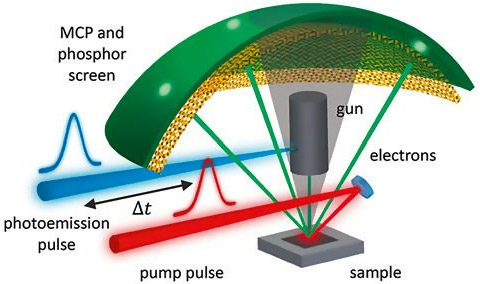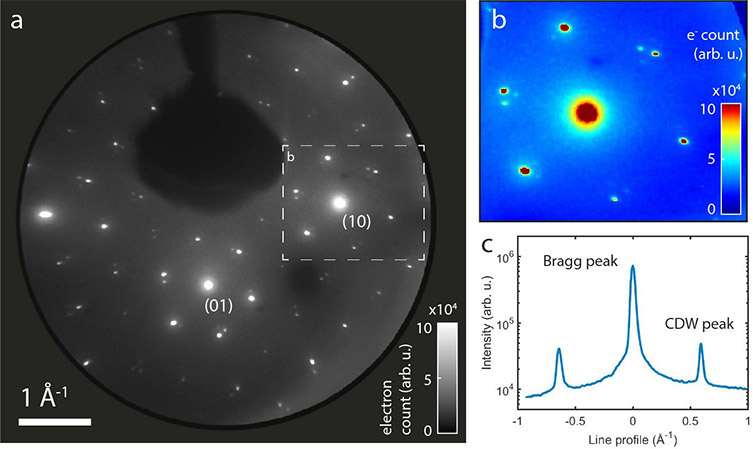Resources
 Part of the Oxford Instruments Group
Part of the Oxford Instruments Group
Expand
Collapse
 Part of the Oxford Instruments Group
Part of the Oxford Instruments Group
Introduction
In the past decades, ultrafast electron diffraction (UED) developed into a powerful tool to study the atomic scale dynamics of bulk media driven strongly out of equilibrium. However, extending this approach for the investigation of structural dynamics of surfaces remains challenging.
Recently, we implemented ultrafast lowenerg electron diffraction (ULEED) in transmission [1] as well as in a back-scattering geometry. [2, 3] Specifically, utilizing a miniaturized laser driven electron source, we map the optically driven phase transition of charge-density wave (CDW) phases at the surface of 1T-TaS2 and the associated charge-ordering kinetics.
Experimental setup

Fig. 1. Schematic of the ultrafast low-energy electron diffraction experiment.
In the back-scattering diffraction geometry, ULEED is realized as an optical pump / electron probe scheme with a variable time delay between a 1030 nm optical pump pulse and a picosecond electron pulse to probe the transient state of the sample’s surface structure (Fig. 1).
Using low-energy electron pulses, a particular difficulty is the pulse dispersion, which limits the achievable temporal resolution. Therefore we employ a small laser-driven electron source to shorten the electron pulse propagation distance while minimizing the shadowed area of the diffraction pattern.
Inside the electron gun a sharp tungsten tip serves as a nanometric photocathode. Under illumination with 400 nm fs laser pulses, the nanotip emits highly coherent electron bunches leading to a temporal resolution on the ps timescale (dependent on the sample source distance).
The electron pulses are subsequently accelerated in the range of 50 – 200 eV and diffracted from the sample’s surface, thus, carrying information about its momentary structure.
To record the resulting diffraction pattern with single electron sensitivity a microchannel plate (MCP) and phosphor screen are used in combination with a Zyla-5.5-CL10 sCMOS camera. As a first sample system, we investigate the transition between the so-called nearly commensurate (NC) and the incommensurate (IC) CDW phase in 1T-TaS2.
Figure 2 displays a diffraction pattern of the NC phase recorded at room temperature, showing Bragg peaks of the atomic lattice surrounded by CDW satellite diffraction spots.
Role of the image acquisition system
Since the information about the investigated structural dynamics is encoded in a series of diffraction patterns, it is essential to record these images in high quality. Here, besides the accurate positions of the diffraction peaks, their width and intensity are of great interest.
As shown in Fig. 2a, the diffraction pattern of the NC phase of 1T-TaS2 is characterized by a number of sharp diffraction peaks, arising from the high coherence of the electron pulses and good sample quality. Furthermore, the diffraction peaks shown in Fig. 2 differ in intensity by three orders of magnitude.

Fig. 2. (a) Diffraction pattern of the NC phase of 1T-TaS2 recorded with pulsed electrons at a kinetic energy of 100 eV (180 s integration), each Bragg peak of the atomic lattice (indexed) is surrounded by a set of CDW satellite diffraction spots. (b) Close up of (10)-diffraction peak and surrounding CDW satellite spots. (c) Cross section through a Bragg peak of the atomic lattice and two CDW diffraction peaks (logarithmic scale), indicating the importance of a wide dynamic range and high resolution.
Accordingly, it is very important to use a camera system that combines high resolution imaging with a wide dynamic range and a high signal to noise ratio to analyze intensity changes and spot profiles of the atomic lattice Bragg peaks as well as the CDW satellite spots in the same diffraction pattern. For this reason, the Zyla-5.5 sCMOS camera system with its cooled 5.5 megapixel sensor and 16 bit dynamic range is perfectly suited for image acquisition in the ULEED experiment.
Summary
Since time-resolved LEED combines both high temporal and k-space resolution together with a method exclusively sensitive to the sample surface, it represents a versatile contribution to the toolbox of ultrafast surface science, which can be employed to study a multitude of sample system, such as surface reconstructions, order-disorder phenomena or the dynamics of adsorbate superstructures.
Date: July 2017
Author: S. Vogelgesang, G. Storeck, S. Schafer, C. Ropers
Category: Application Note
